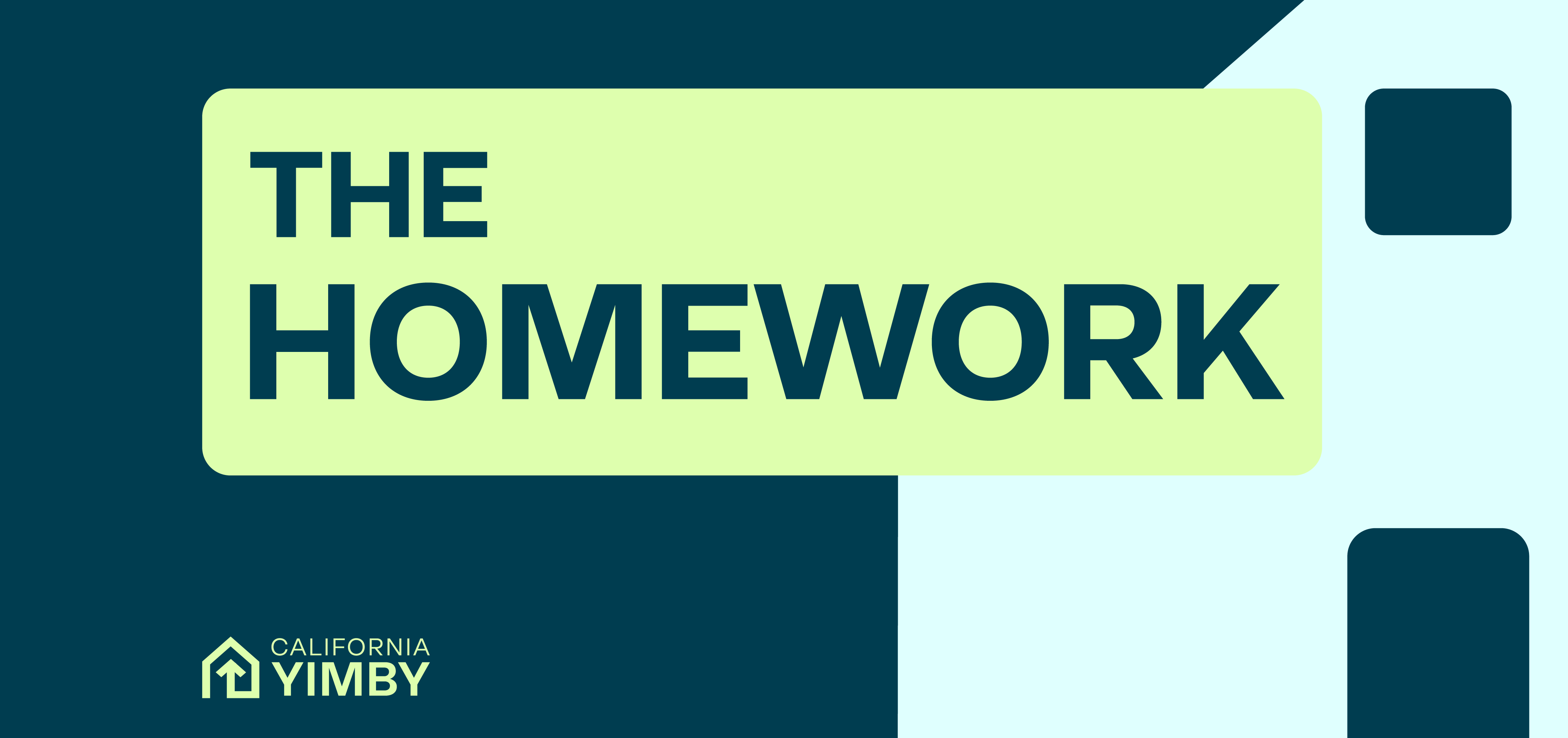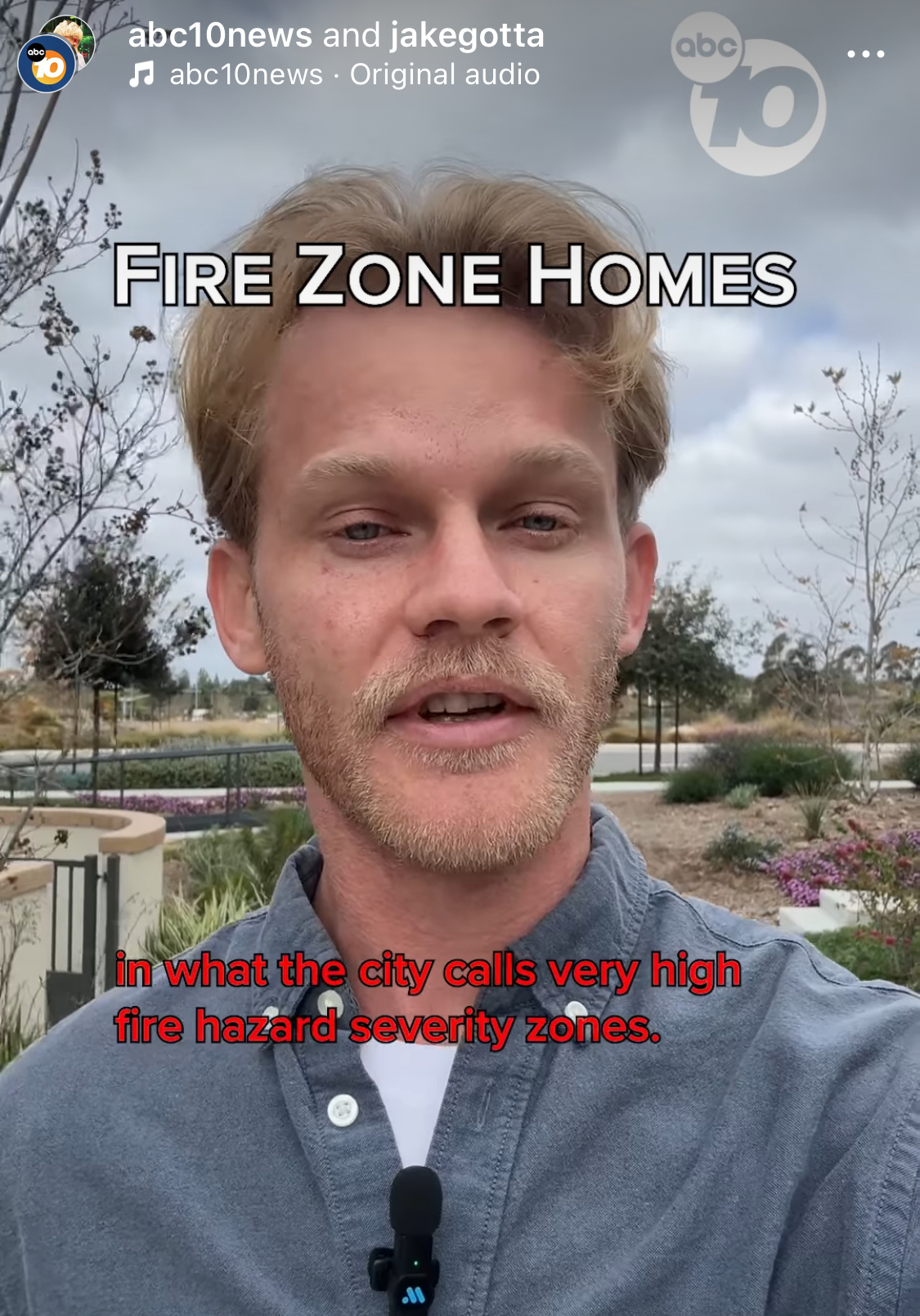The Homework: February 14, 2025

Welcome to the February 14, 2025 Main edition of The Homework, the official newsletter of California YIMBY — legislative updates, news clips, housing research and analysis, and the latest writings from the California YIMBY team.
News from Sacramento
The deadline for the Legislature to introduce bills to be considered during the current session is February 21. However, we expect many legislators may introduce “spot bills,” which are placeholders for legislation that is still being developed, in order to submit final bill language after the deadline has passed. Stay tuned for a more detailed rundown of specific bills in the next edition of The Homework.
California YIMBY: 2025 Policy Framework
For the 2025 legislative session, California YIMBY’s sponsored and high-priority legislation will fit into one of three priority areas. These policy priorities guide our decisions about which bills we work on, including those we sponsor and those we categorize as high-priority. During the 2025 legislative session, California YIMBY will be advocating for policies that support the following themes:
- Building back better, faster, and more sustainably: The catastrophic Los Angeles fires have highlighted the need to take fire resilience and preparation seriously. While recovery gets underway, we need to also focus on making it faster and easier to build back better – and not just in neighborhoods devastated by fire. Most of California’s existing urban land is in areas that are substantially less vulnerable to wildfire, but for historic reasons, we’ve largely banned new housing in these areas. Our legislative priorities for 2025 will focus on easing prohibitions on housing growth and streamlining the process builders must follow to get building permits in these lower-risk areas. We’ll also focus on reforms that ensure we apply our existing environmental laws to housing in ways that improve affordability and sustainability while reducing environmental impacts.
- More homes near transit: Some of the most expensive – and desirable – housing in California is located in areas with abundant public transit amenities, like light rail, buses, and trains. While state taxpayers have made tens of billions of dollars of investments in these transit systems, too many of our cities continue to ban most housing growth near public transit. These housing bans drive up costs, and prevent our transit systems from reaching their potential to reduce traffic congestion, speed up commute times, and slash the pollution that causes climate change. In 2025, California YIMBY will work to pass legislation that makes new housing a legal right within one-half mile of major public transit stops, give more Californians access to the transit systems they paid for – and make our state more affordable, sustainable, and climate-resilient.
- Renewing the dream of homeownership: California YIMBY and our allies have a solid track record of reforming existing housing laws and accelerating progress on our goal of enabling affordable pathways to home ownership. In 2025, we’ll double-down on our successful efforts to expand these opportunities by refining existing law, continue our efforts to chip away at abuse of historic preservation laws to block housing, and accelerate progress on building ADUs.
California YIMBY is still finalizing our full legislative package for 2025, but we have already introduced the following sponsored bills:
- SB 79 (Wiener): This bill will make it faster and easier to build multi-family housing near transit stops, like train and rapid bus lines, by making it legal for more homes to be built in these areas, and streamlining existing permit review processes.
- AB 253 (Ward): This bill will speed up the approval process for new homes by allowing home builders to hire a licensed and certified third-party reviewer for review of housing permit applications if the local government cannot or does not complete their permit review within 30 days.
- AB 413 (Fong): This bill will require the California Department of Housing & Community Development (HCD) to translate key state housing guidelines and handbooks into the non-English languages commonly spoken in California.
- SB 9 (Arreguín): This bill clarifies that all Accessory Dwelling Units (ADUs) are exempt from owner-occupancy requirements as required by AB 881 (Bloom 2020), not only those built after the law went into effect.
We’ll have more legislation to announce shortly. Legislative committee season is expected to begin later this month, so be sure to stay tuned for future editions of The Homework (and follow California YIMBY’s Twitter and Bluesky channels, @cayimby and https://bsky.app/profile/cayimby.bsky.social), to stay current on housing policy research, news, and legislative updates.
Housing Research & Analysis
The Impact of Land Use Planning on Wildfire Risk: A Study in Southern California
Over the past three decades, most new homes in California have been built in or near the wildland-urban interface (WUI). As catastrophic fires in the WUI grow worse with climate change, effective fire-risk reduction strategies are essential.
In Land Use Planning and Wildfire: Development Policies Influence Future Probability of Housing Loss, Alexandra D. Syphard, Avi Bar Massada, Van Butsic, and Jon E. Keeley modeled three different development scenarios in San Diego to investigate how land use planning can influence the future probability of housing loss due to wildfires.
Key Takeaways:
- Infill development produced the most efficient use of land, with the highest housing density; and the homes built were at the lowest fire risk.
- Leapfrog development – the construction of housing in isolated, undeveloped areas – consumed the most land to build homes at the lowest density; the resulting homes were at the highest risk of fire.
- To mitigate the risk of housing loss from wildfire, policymakers should concentrate growth on infill parcels where the risk is lowest.
Calling the Bluff: First the Reforms, Then the Funds
Housing costs are a contentious political issue in most American cities. Demands for building more “affordable housing” run up against a variety of politically-powerful stakeholders, who are ambivalent (at best) about neighborhood change; many constituents are fiercely opposed to even the smallest hints of growth.
In response, many elected officials oppose naturally-affordable, market-rate multifamily housing while campaigning on the need for more subsidized, deed-restricted affordable housing.In a recent white paper, Alex Armlovich, Christopher S. Elmendorf, and Sam Jacobson propose a novel solution: make big cities’ eligibility for Low Income Housing Tax Credits (LIHTCs), the single largest source of affordable housing subsidy funding, conditional on adopting pro-housing regulatory reforms.
Key Takeaways:
- In many high-demand urban areas, interest groups exploit complex zoning regulations and subjective, politicized housing approvals processes to secure their own interests, which significantly raises the cost of housing by preventing the supply of homes from growing to meet demand.
- However, elected officials in these cities are strongly supportive of subsidized housing for low-income households
- As such, making affordable housing funding contingent on reforming zoning and permitting processes for all housing could break the political impasse over housing in high-cost cities.
Houser Headlines
- To Rebuild Los Angeles, Fix Zoning
- How Will L.A. House Everyone Now?
- Newsom just quietly floated an idea that could help fix California’s housing and fire recovery crises
- Cal Fire’s predictions didn’t foresee the Altadena inferno. Now it’s changing its fire-hazard maps – Los Angeles Times
- That Giant Sucking Sound? It’s Climate Change Devouring Your Home’s Value.
- How many SF workers moved at least 50 miles away from their jobs
- In the rush to rebuild, one topic is taboo: What should be built differently — or not at all?
- With wildfires and homelessness raging, it’s time to bring back the shack
- L.A. fires hit family wealth. Daunting challenges await those trying to recover it – Los Angeles Times
- California fires destroyed or damaged nearly half of Black homes in Altadena
- How a century-old traffic ordinance paved the way for L.A.’s deadly streets
YIMBY Social – Top Posts

Share the good word
We welcome your ideas and feedback — send story tips and ideas to Homework@cayimby.org.